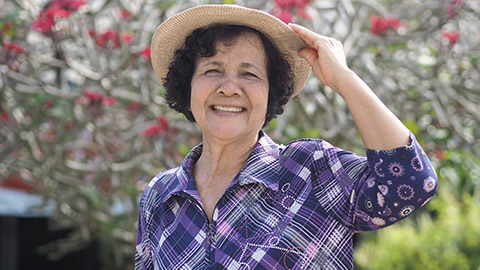After analysing your client’s needs, you need to identify relevant services, and support your client to access them, using a collaborative, person-centred, strengths-based approach.
If your own organisation cannot meet all of the client’s service needs, you will need to refer your client to external services and agencies.
It is important to match your client with services that address all their coexisting needs. This may mean referring your client to multiple agencies and tracking how various services are working together.
This topic will cover:
- common service requirements and features of the major industry sectors.
- researching and locating information about a range of diverse services to meet clients’ needs
- networks and specialist services available
- using a strengths-based perspective to identify other options and make referrals
- supporting a client to make decisions about services and referrals, and encouraging them to self-advocate
- evaluating your own organisation’s capacity to meet your client’s needs.
You are not expected to have an in-depth knowledge of all the various areas of service provision across the community services industry, but you will need a broad understanding of the major industry sectors. You will also need good skills in researching information about services to meet a range of diverse needs.
Community services in Australia consist of a complex network of government and non-government organisations that provide a diverse range of services to meet individual, family, group and community needs. Broadly speaking, the overall purpose of providing community services is to maintain social cohesion by reducing the impact of unmet needs. Services focus on supporting the welfare of vulnerable social groups at an individual, family, group or community level.
The community services industry is one of the largest in Australia. It is complex and diverse and can be categorised in several different ways:
- By industry sector or client/target group – For example, aged care, disability services, mental health services, children’s services, alcohol and other drugs services, health services, women’s services, housing and accommodation/homelessness support, crisis accommodation, youth services, income support, education and training support, employment support, migrant/refugee services, domestic and family violence services, child protection—the list is potentially endless.
- By organisational structure/type of organisation – For example, state/territory government departmentsand agencies, Commonwealth government departments and agencies, non-government agencies and organisations, not-for-profit agencies and organisations, for-profit agencies and organisations, and charitable foundations and organisations
- By client group/target group – For example,individual client services, family services and community/group services
- By broad area of need – For example, economic/financial/income support, housing, social inclusion, health, education, employment, family support, community and special needs groups.
Community services industry provides a wide range of services across many sectors, including:
- Home and Community Care
- Disability Support
- Homelessness Support and Social Housing
- Mental Health Services
- Foster Care and Out-of-Home Care
- Child Safety and Support
- Aged Care
- Employment Services
- Early Childhood Education and Care
- Family and Domestic Violence Services
- Community Education
- Multicultural Support Services
- Aboriginal and Torres Strait Islander Community Services
- Community Health
- Youth Support
- Community Legal Services
- Financial Counselling
- Health Promotion
(Community Services Industry Alliance)
Researching Information About Community Services
The simplest way to search online for information about services is to use search terms that reflect areas of need, such as ‘income support’, ‘aged care’, ‘child protection’, ‘housing support’, ‘crisis care’ or ‘mental health’.
Alternatively, you can search using terms that reflect client groups and industry sectors, such as ‘disability’, ‘youth’, ‘seniors or older Australians’, ‘migrants/CALD’ (culturally and linguistically diverse) or ‘Aboriginal and Torres Straits Islanders’.
As well as searching online, you can use service directories and industry networks. You can explore your own community for information through libraries, local councils and community centres.
Explore
These links provide an overview of the community services industry and its complexity:
- The Health and Community Services section of the My Skills website.
- ‘Community Services Sector Overview’ from the Report on Government Services 2013 by the Productivity Commission.
Specialist Services and Networks
Services can be categorised according to special needs defined by culture, health, age, disability and other diversity factors. Organisations and services exist for specific groups, such as various ethnic and cultural groups, gender-diverse groups, and people with specific health issues and disabilities or age-related needs.
Example
Ishar Multicultural Women’s Health Centre, LGBTIQ Connect Groups, Autism Connect and Advocare are organisations that provide specialist services for specific groups.

Using a strengths-based perspective to identify options for meeting clients’ needs means helping clients to identify the strengths and resources that they are already using to deal with their situation.
Strengths and resources can include the following areas: Resilience‘Resilience’ has become a popular concept in recent years. It refers to having the ability to cope with stress and hardship, and call upon a reservoir of strengths and resources to handle adversity.
Many clients in community services who live with hardship and difficult situations are more resilient than they recognise.
You can build your resilience by:
- Individual Strengths: knowing your strengths and keeping them in mind
- Family or Household: building your self-esteem — have confidence in your abilities and the positive things in life
- Friends and Neighbours: build healthy relationships
- Community: knowing when to ask for help
- Strengths and Resources: managing stress and anxiety levels
- Making Referrals: working on problem solving skills and coping strategies
Healthdirect
Individual strengths
Individual strengths may include specific skills and knowledge, a positive attitude, and strategies developed from solving problems in the past. Helping your clients to recognise these strengths is part of using a strengths based approach to assessing a client’s needs and supporting them to identify and choose options for meeting those needs.
Family or household
Your client’s family may have strengths and resources that they can contribute, for example, helping with practical tasks, such as transport, childminding and shopping; or providing emotional support.
Friends and neighbours
Friends and neighbours can also be a source of practical and emotional support. Having a supportive network of friends and neighbours can also increase the client’s sense of belonging, safety and self-esteem.
Community strengths and resources
The community or communities to which the client belongs can also contribute strengths and capacities. Being part of a community supports identity, self-esteem and a sense of belonging.
Making Referals
Once needs have been identified and prioritised, you might consider referring your client to other services to meet coexisting needs for which your own organisation cannot provide.
It is always essential to explain referral options to your client—providing enough information for them to make informed choices and decisions—and to gain their consent to the referral.
Review and follow your own organisation’s policies and procedures for making referrals, and the other organisation’s policies and procedures, including its eligibility criteria.
Make sure the information you provide in a referral is relevant, accurate, up to date, sufficient and objective.
Case Study

Elsie
Elsie is in her 60s. She cares for five of her grandchildren, whose ages range from 4 to 15 years. They live in a four-bedroom house in a small country town. Elsie is well known within her local community and has an extensive network of friends and extended family members. She is respected as an elder with a wealth of cultural and historical knowledge, and she is a member of the regional land council.
Recently, Elsie’s health has been deteriorating.
She has osteoarthritis, diabetes and a heart condition, all of which are making it difficult for her to continue participating in community activities and caring for her grandchildren.
She is determined to continue looking after her grandchildren, but she is worried about how she will cope as her health gets worse and she becomes less physically active.
Members of Elsie’s extended family help out with child care, household tasks, gardening (she has an extensive vegetable garden in her backyard) and shopping. They often take her to medical and other appointments. Her next-door neighbour, Josie, keeps an eye on her and often drops in for a cup of tea and a chat. They have been close friends for many years and have supported each other through many difficult times.
Elsie’s GP has referred her for home support services through a local aged care organisation.
They have offered to provide cleaning and home-help services, transport and regular medical checks.

As part of a collaborative, person-centred, strengths-based approach to assessing coexisting needs, you should work to support and develop your clients’ capacities to make choices and decisions, and ability to advocate for themselves. This empowers your clients and increases their ability to identify and address their own issues and needs.
Your role will include:
- Finding and sharing information about services and options available to meet the needs you and your client have identified and prioritised
- Evaluating your own organisation’s capacity to meet your client’s needs, and providing information about referrals to external agencies and services
- Supporting your client to make informed choices and decisions
- Supporting your client to advocate on their own behalf.
Empowerment
‘Empowering’ someone means to enable them to become more autonomous, independent and in control of their lives. Clients of community services often find themselves in positions where they are relatively powerless to change their situations and the factors that affect their lives, so it is particularly important to work to empower them.
As a community services worker, you can empower your clients by:
- Providing clients with information so they can make informed choices and decisions
- Sharing your knowledge and experience
- Modelling and teaching skills in areas such as problem-solving, communication, negotiation, conflict resolution and advocacy
- Listening to clients’ concerns, ideas, perspectives, experiences, goals and preferences
- Showing respect for clients as individuals who have value and rights
- Accepting and valuing diversity
- Acknowledging clients’ capacities, strengths and skills
- Including clients in making decisions and choices about services and other factors that affect them.
Within the context of assessing needs, you can:
- Support your clients to identify and prioritise their own needs
- Use a strengths-based approach
- Support clients to make informed choices and decisions about services to meet their needs.
The Victorian Government’s framework for including the ‘client voice’ in community services clearly illustrates the basic principles of empowerment:
The framework is based on five key principles developed with clients and staff of community services. They are accompanied by prompts to help put them into practice at the individual, organisation and system levels. They are followed by key questions and tips from clients.
The five principles are:
- The client voice is essential for quality and safety.
- Clients have expertise.
- The client voice is part of everyone’s role.
- There are many client voices.
- The client voice leads to action.
Health and Human Services (Vic), Client Voice Framework for Community Services
To be truly empowered, a person must have strengths, resources and control across all areas of need, as illustrated by the ‘empowerment circle’:
Empowerment relies on having access to a range of resources and supports in your life, including
- Supportive people and relationships
- Emotional resilience
- Physical and mental health
- A sense of ‘belonging’ and participation in your community
- A sense of identity
- Knowledge of your rights and responsibilities
- Skills in communicating your needs and preferences.
Keep the empowerment circle and its eight areas of life in mind when you are assessing clients’ coexisting needs.
Explore
Visit the following links to learn more about empowerment and empowering your clients:
- 'Empowerment’ from Youth AOD Toolbox
- ‘Principles of Recovery Oriented Mental Health Practice’ from the Department of Health
- Disability Rights: Facilitating the Empowerment of People With Disability by the Australian Human Rights Commission
Self-Advocacy
To ‘advocate’ for someone means to speak on their behalf and represent them. Self-advocacy means speaking for and representing yourself. Being able to advocate for yourself shows that you are empowered, at least to some degree.
Self-advocacy is often discussed within the context of disability, mental health and aged care services, but it can apply to any community services sector.
Supporting your clients to advocate for themselves to access services to meet their needs is part of working to empower them.
To advocate for themselves, a person needs:
- Effective communication skills
- To know what their rights and responsibilities are
- Belief in their value or worth as a person, and their entitlement to human and civil rights
- Information about the relevant service, organisation or issue
- Confidence or trust in themselves and others
- Clear goals.
You can help your clients to develop skills in advocating for themselves to access services that meet their needs by
- Modelling and teaching effective communication skills, including assertive communication techniques
- Providing information about the client’s human rights, civil rights and responsibilities, and their rights and responsibilities as clients
- Working in ways that develop empathy, trust, confidence and self-esteem
- Providing information about services and resources available to meet the client’s needs, including
- eligibility criteria, service features, and application or referral processes
- Providing opportunities for the client to practise expressing their goals, needs and preferences; and making choices and decisions about services and other matters that affect them
- Providing practical and emotional supports

It often happens that a single organisation cannot meet all of a client’s coexisting needs, which means that the client should be referred to external agencies and services.
Large organisations may have multiple service areas and more capacity to meet a range of needs, while smaller or more specialised organisations may have a more limited scope. Recognising your own organisation’s capacities and gaps is essential when you are assessing a person’s coexisting needs.
Example: Rainbow Community Centre
Rainbow Community Centre has a range of services directed towards the needs of its local community, including:
- Support groups and playgroups for young parents
- Activity groups and social groups for seniors
- English language classes and conversation groups for women from CALD communities
- Cooking classes
- After-school sports and recreation programs
- An op shop with low-cost clothing, toys and books
- A food bank for low-income community members.
It also provides information about other services and community resources and offers referrals and support to access other services.
Watch
When working in an organisation, it might be required that a needs assessment is required.
Watch this video to explore a needs assessment.
3:42 Minutes
In summary, this topic has provided a comprehensive guide to addressing clients' needs in community services. You have learned the importance of identifying relevant services and supporting clients to access them through a collaborative, person-centered, and strengths-based approach. Recognizing that your organization may not meet all client needs, the topic emphasizes the necessity of referring clients to external services and agencies, ensuring a holistic approach to service provision. The exploration covers common service requirements features of major industry sectors, researching diverse services, and utilizing a strengths-based perspective for effective referrals. Additionally, you have gained insights into supporting clients in decision-making, self-advocacy, and evaluating your organization's capacity to meet their needs. This knowledge equips you to navigate the complexities of service coordination, fostering a client-centric approach that addresses diverse and coexisting needs through a network of relevant services.
